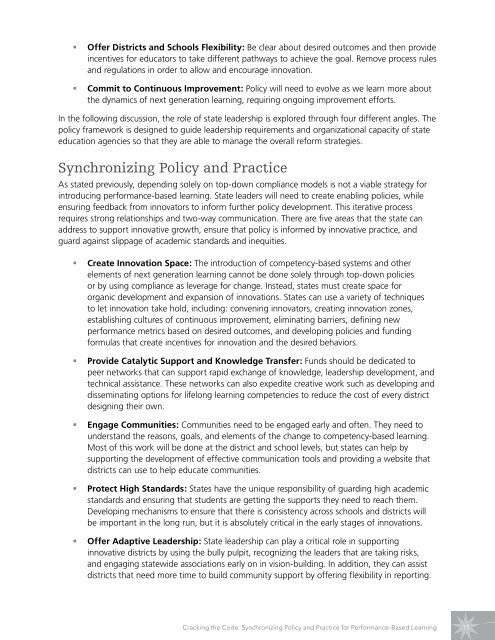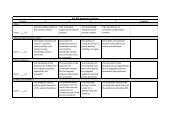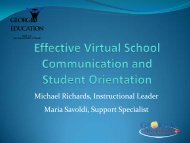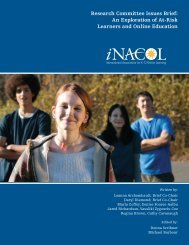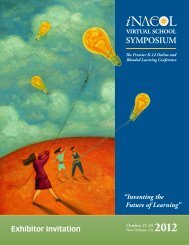Cracking the Code: - The Nellie Mae Education Foundation
Cracking the Code: - The Nellie Mae Education Foundation
Cracking the Code: - The Nellie Mae Education Foundation
- No tags were found...
Create successful ePaper yourself
Turn your PDF publications into a flip-book with our unique Google optimized e-Paper software.
• Offer Districts and Schools Flexibility: Be clear about desired outcomes and <strong>the</strong>n provideincentives for educators to take different pathways to achieve <strong>the</strong> goal. Remove process rulesand regulations in order to allow and encourage innovation.• Commit to Continuous Improvement: Policy will need to evolve as we learn more about<strong>the</strong> dynamics of next generation learning, requiring ongoing improvement efforts.In <strong>the</strong> following discussion, <strong>the</strong> role of state leadership is explored through four different angles. <strong>The</strong>policy framework is designed to guide leadership requirements and organizational capacity of stateeducation agencies so that <strong>the</strong>y are able to manage <strong>the</strong> overall reform strategies.Synchronizing Policy and PracticeAs stated previously, depending solely on top-down compliance models is not a viable strategy forintroducing performance-based learning. State leaders will need to create enabling policies, whileensuring feedback from innovators to inform fur<strong>the</strong>r policy development. This iterative processrequires strong relationships and two-way communication. <strong>The</strong>re are five areas that <strong>the</strong> state canaddress to support innovative growth, ensure that policy is informed by innovative practice, andguard against slippage of academic standards and inequities.• Create Innovation Space: <strong>The</strong> introduction of competency-based systems and o<strong>the</strong>relements of next generation learning cannot be done solely through top-down policiesor by using compliance as leverage for change. Instead, states must create space fororganic development and expansion of innovations. States can use a variety of techniquesto let innovation take hold, including: convening innovators, creating innovation zones,establishing cultures of continuous improvement, eliminating barriers, defining newperformance metrics based on desired outcomes, and developing policies and fundingformulas that create incentives for innovation and <strong>the</strong> desired behaviors.• Provide Catalytic Support and Knowledge Transfer: Funds should be dedicated topeer networks that can support rapid exchange of knowledge, leadership development, andtechnical assistance. <strong>The</strong>se networks can also expedite creative work such as developing anddisseminating options for lifelong learning competencies to reduce <strong>the</strong> cost of every districtdesigning <strong>the</strong>ir own.• Engage Communities: Communities need to be engaged early and often. <strong>The</strong>y need tounderstand <strong>the</strong> reasons, goals, and elements of <strong>the</strong> change to competency-based learning.Most of this work will be done at <strong>the</strong> district and school levels, but states can help bysupporting <strong>the</strong> development of effective communication tools and providing a website thatdistricts can use to help educate communities.• Protect High Standards: States have <strong>the</strong> unique responsibility of guarding high academicstandards and ensuring that students are getting <strong>the</strong> supports <strong>the</strong>y need to reach <strong>the</strong>m.Developing mechanisms to ensure that <strong>the</strong>re is consistency across schools and districts willbe important in <strong>the</strong> long run, but it is absolutely critical in <strong>the</strong> early stages of innovations.• Offer Adaptive Leadership: State leadership can play a critical role in supportinginnovative districts by using <strong>the</strong> bully pulpit, recognizing <strong>the</strong> leaders that are taking risks,and engaging statewide associations early on in vision-building. In addition, <strong>the</strong>y can assistdistricts that need more time to build community support by offering flexibility in reporting.<strong>Cracking</strong> <strong>the</strong> <strong>Code</strong>: Synchronizing Policy and Practice for Performance-Based Learning 15


